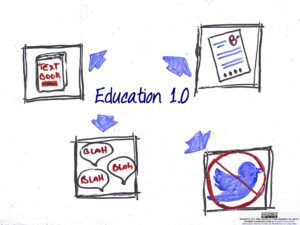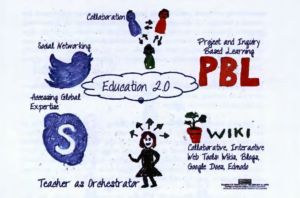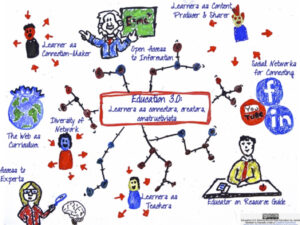When the presenters kicked off the presentation, I realized I was stepping into unknown territory. The terms “Web 1.0” and “Web 2.0” were a complete mystery to me. But as the talk unfolded, something amazing happened—I began to understand. At the beginning of the presentation, I had no clue about “Web 1.0” and “Web 2.0.” It was like a blank slate in my mind. But as they spoke, I started to gather so much new information. Now, armed with all this knowledge, I’m thrilled! I can’t wait to dive into writing a blog post about Web 1.0 and Web 2.0. It’s incredible how much I’ve learned, and I’m eager to share it with you.
“The web influences people’s way of thinking, doing and being, and people influence the development and content of the web. The evolution of the web from Web 1.0 to Web 2.0 and now to Web 3.0 can be used as a metaphor of how education should also be evolving, as a movement from Education 1.0 toward that of Education 3.0. The Web, Internet, Social Media, and the evolving, emerging technologies have created a perfect storm or convergence of resources, tools, open and free information access.” (Jackie Gerstein)
My perspective on this matter is that I believe the rapid pace of technological progress in our lifetime has made it challenging to stay abreast of the myriad tools available to us. Just as we get the hang of a new social media app or educational resource, an even more advanced option emerges. Considering the constant stream of new and improved technologies, the thought of incorporating web tools into our classrooms can feel overwhelming. Mastering one tool only to find another on the horizon adds a layer of complexity to navigating the digital landscape of education. As educators, the task of selecting and integrating these tools becomes a dynamic process of adaptation and learning.
Gerstein’s Metaphor: Moving from Education 1.0 to Education 3.0
Jackie Gerstein’s metaphorical analogy between the progression of the Internet from Web 1.0 to Web 3.0 and the evolution of education from Education 1.0 to Education 3.0 offers a perspective for understanding the shifting dynamics of learning and teaching. Exploring Gerstein’s metaphor and its ramifications allows us to delve into the changing landscape of education.
1)Evolution of Learning Paradigms:
Education 1.0(Pedagogical, Essentialist Education):This period is compared to the initial days of the internet, Web 1.0, characterized by a one-sided flow. In Education 1.0, students are akin to passive receivers of information, similar to users absorbing content from early websites. The emphasis lies on essentialist, behaviorist education, highlighting uniform learning where every student is anticipated to grasp identical material. Teachers serve as the primary custodians of knowledge, and education largely involves a unilateral transfer from teacher to student.

Education 2.0(andragogical, Constructivist Approach): Education 2.0 corresponds to the interactive era of the internet, Web 2.0. Here, there is more interaction and collaboration between teachers, students, and content. Similar to how Web 2.0 introduced user-generated content, Education 2.0 allows for more student-centered, participatory learning experiences. Teachers begin to use blogs, podcasts, social bookmarking, and other Web 2.0 tools to enhance traditional teaching methods. However, the underlying framework of Education 1.0 often still influences how these technologies are implemented.

Education 3.0:Heutagogical, Connectivist Approach): Education 3.0 reflects the idea of Web 3.0, offering a vision of more individualized, self-directed, and interconnected learning encounters. Within Education 3.0, learners take charge of their educational paths. They establish their learning goals, decide on their preferred learning methods, establish learning communities, and employ diverse digital tools to produce and distribute knowledge creations. The educator’s role shifts to that of a supportive facilitator, guiding and assisting learners as they independently explore their learning paths.

2)Learner-Centric Focus: Education 3.0 marks a departure from standardized, uniform approaches seen in Education 1.0, instead emphasizing personalized, interest-driven learning. Students under this model are empowered to define their learning goals, determine their preferred learning methods, and participate in meaningful, real-world tasks. This shift enables learners to engage deeply with their education, fostering a sense of autonomy and relevance that leads to more effective learning outcomes.
3)Role of Teachers: In the landscape of Education 3.0, teachers evolve into facilitators and mentors, aiding students on their self-directed learning paths. They guide learners in navigating a plethora of resources, recommending suitable tools, and mentoring them as they craft knowledge artifacts. This approach shifts the traditional teacher-student dynamic towards a collaborative partnership, empowering students to take charge of their learning. The result is a dynamic educational environment where students thrive through exploration, creativity, and personalized growth.
4)The Power of Web 3.0:Web 3.0 introduces enhanced, immersive, and personalized encounters, mirroring the tailored internet experiences users may already have. Just as users might have personalized internet profiles based on their interests and browsing history, Web 3.0 enables customized learning experiences. This advancement brings forth a new era where learners can delve into content that aligns precisely with their preferences and learning styles, fostering deeper engagement and more meaningful educational journeys.
5)Benefits for Students: The shift to Web 3.0 is especially advantageous for students who perform well in independent, group environments. These learners can investigate, produce, and work together on meaningful learning artifacts because they have access to a wealth of resources and can establish connections with experts. Students gain vital abilities through this process, including teamwork, critical thinking, and problem-solving—all of which are essential in the digital age. By enabling students to take an active role in their education, Web 3.0 sets them up for success in a world that is becoming more dynamic and interconnected.
6)Challenges for Teachers: In Education 3.0, educators take on new responsibilities as mentors and facilitators, and they also need to embrace a growth mindset. To accommodate this change, traditional teaching methods must give way to a focus on student-centered learning. Teachers enable students to explore, create, and collaborate in meaningful ways by embracing new methodologies and concentrating on what works best for their learning. The way that teaching philosophy has evolved allows teachers to change with the times and make sure that students learn in a setting that suits their interests and needs.
“Equity in Education 3.0: Addressing the Digital Divide”
The shift to Education 3.0 and Web 3.0 presents a dichotomy in the experiences of students, highlighting the digital divide. On one hand, privileged students who are self-motivated, digitally literate, and have access to technology at home thrive in this new learning environment. They benefit from the myriad opportunities for self-directed learning and excel in collaborative, inquiry-based settings characteristic of Education 3.0. However, on the other hand, disadvantaged students face significant challenges. Those lacking reliable internet access or technology may struggle to fully engage in this digital learning landscape. Additionally, students who require more structured guidance might find the shift overwhelming without adequate support systems in place. Learners who are accustomed to traditional, teacher-centered instruction may feel out of place in a more self-directed environment. Thus, addressing the digital divide becomes crucial in ensuring equitable access to the benefits of Education 3.0 for all students.
“Equity in Educator Readiness for Education 3.0: Bridging the Training Gap”
The transition to Education 3.0 also highlights disparities among teachers, emphasizing the need to bridge the training gap. Privileged teachers, who are tech-savvy, adaptable, and eager to embrace new pedagogical approaches, thrive in this evolving landscape. They benefit from access to professional development opportunities and resources that aid in the effective integration of technology. On the other hand, disadvantaged teachers face hurdles in this shift. Educators who resist change, lack training in digital tools, or hold on to traditional teaching methods may struggle to navigate Education 3.0. Additionally, those with limited access to technology or support systems for implementing innovative practices find it challenging to adapt. Therefore, addressing the training and support needs of all educators becomes essential to ensure a smooth transition to Education 3.0 and promote equitable opportunities for professional growth.
I think many educators I’ve spoken to feel overwhelmed when it comes to using new technology tools in their classrooms. They often lack the training needed to confidently incorporate these tools into their teaching methods. As a result, they tend to stick to what has worked for them in the past to avoid potential challenges. However, wouldn’t it be exciting if students could witness their teachers taking risks and trying new things, even if they don’t always succeed? We all learn and grow by trying new ideas, even if they don’t go as planned. The problem is, that we’re so focused on getting everything perfect that we become afraid of making mistakes and learning from them. The word “failure” can seem scary, but it’s just a part of the learning process.
We should remember that we don’t have to use every single tool available to us. The advantage of Web 2.0 and 3.0 is the wide array of tools they provide for educators, and many of them don’t cost anything. When I come across new features and tools in Web 2.0 and 3.0, I’m excited to experiment with new tech tools that can help make education more engaging. These tools might not always be successful; they might fail with one group but work exceptionally well with another. Nevertheless, I enjoy using new tools. During this course, I have learned about many different tools that I had not heard of before. I am amazed by these tools. In every presentation, I learn about new tools that my classmates have used.
